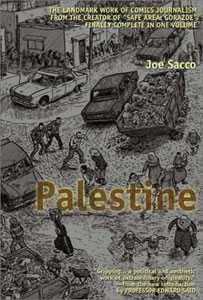Palestine (comics)
| Palestine | |
|---|---|
 Palestine 2001 Cover | |
| Author | Joe Sacco |
| Illustrator | Joe Sacco |
| Country | United States |
| Language | English |
| Subject | Israeli-Palestinian conflict |
| Genre | Comics, New journalism |
| Publisher | Fantagraphics |
Publication date | 2001 (originally released in 1996) |
| Media type | Print, Paperback |
| Pages | 285 |
| ISBN | 0-224-06982-9 |
| OCLC | 50841111 |
Palestine is a graphic novel written and drawn by Joe Sacco about his experiences in the West Bank and the Gaza Strip in December 1991 and January 1992. Sacco gives a portrayal which emphasizes the history and plight of the Palestinian people, as a group and as individuals.
Plot summary
The book takes place over a two-month period in late 1991 early 1992, with occasional flashbacks to the expulsion of the Arabs, the beginning of the Intifada, the Gulf War and other events in the more immediate past. Sacco spent this time meeting with Palestinians in the West Bank and Gaza Strip and the narrative focuses on the minute details of everyday life in the occupied territories, presenting the daily struggles, humiliations and frustrations of the Palestinians.
Sacco’s visit to Israel and the occupied territories is presented chronologically, from his arrival to his departure, through dramatic scenes with only a handful of diversions to present the historical and personal background. Most of the scenes in the book are conversations between Sacco and Palestinians, and though the events they talk about are presented visually the dialogue is always present as a form of narration for the events.
Sacco devotes whole pages to drawings of the destitution and squalor prevalent in the occupied territories. Though Sacco is the principal narrator at times he steps aside and allows other characters to present their stories uninterrupted and without interpretation. In his drawings, though most of the panels are presented as a “side view” of Sacco, other characters and their surroundings, there are several panels which present the scene as it looks from Sacco’s point of view. There are also panels which present a bird’s eye view of places like the refugee camps or Jerusalem.
In Palestine Sacco positions himself knowingly as the westerner going to the Middle East to confront a reality unfamiliar to his American audience. Sacco does not delude himself that as a "neutral" observer he can remain invisible and have no effect on the events around him, instead accepting his role and concentrating on his personal experience of the situation. Though his goal is to document events and interview Palestinians he is affected by the reality of the occupied territories and cannot help but participate in, and comment on, demonstrations, funerals, roadblocks and encounters with soldiers. Towards the end he becomes even more active as he shares food and lodgings with the Palestinians he interviews and even breaks curfew with them while in the Gaza Strip.
In the book Sacco references Joseph Conrad's Under Western Eyes, Heart of Darkness, and Edward Said's Orientalism to draw links between the situation he is witnessing and colonialism. Towards the end of the book, when challenged by an Israeli that he hasn't experienced their POV, he responds that the Israeli POV is what he has internalized his whole life, and although another trip would be necessary to fully experience Israel, that wasn't why he was there. (p. 256)
Publication history
The graphic novel, published in 2001 by Fantagraphics Books, is an assembly of nine stories first published in comic form in 1993; the single volume edition includes an introduction by Edward Said. In 1996, the comic was awarded the American Book Award by the Before Columbus Foundation.
External links
- Joe Sacco on Footnotes in Gaza and Palestine - Interview on the 7th Avenue Project radio show
See also
| |||||||||||||||||